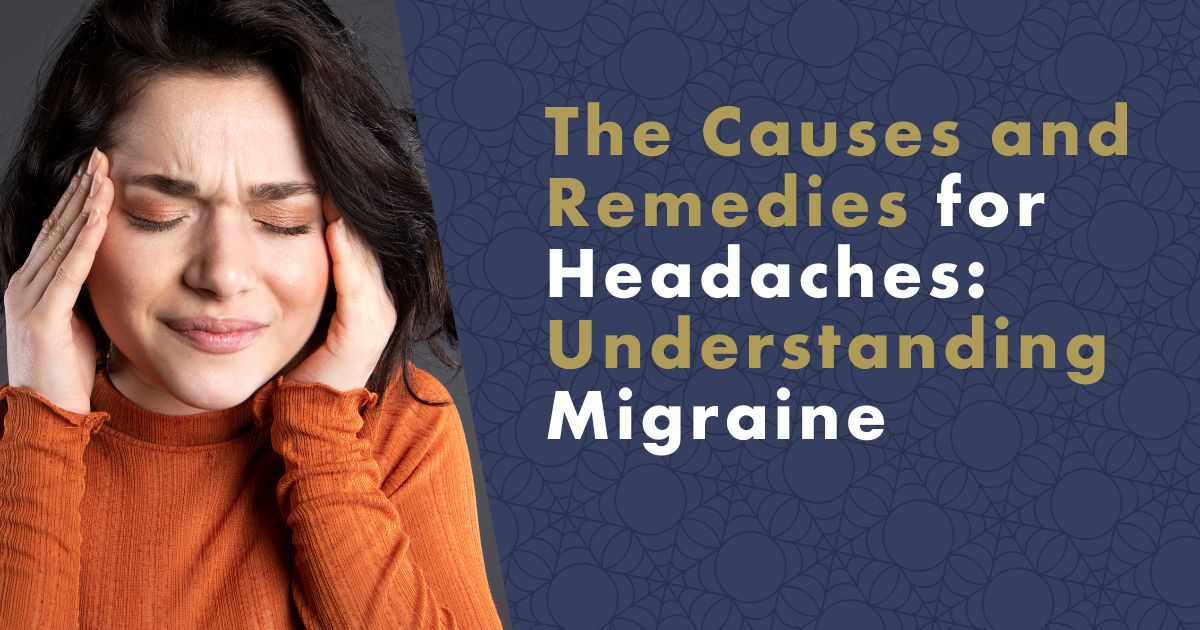Migraines, characterized by intense throbbing headaches often accompanied by nausea and sensitivity to light and sound, can be a debilitating experience for those who suffer from them. Understanding the underlying causes of migraines is crucial in developing effective strategies for prevention and relief. In this article, we delve into the intricate web of factors that contribute to migraines and explore a range of remedies for managing and alleviating the pain associated with headaches. From lifestyle changes to medical interventions, we aim to provide comprehensive insights into the multifaceted nature of migraines and empower readers with knowledge to better navigate and mitigate the impact of these persistent headaches.

Causes of Headaches
The first step towards relieving headaches is identifying their causes. Headaches can be caused by various factors:
- Stress, fatigue, and tension
- Weather changes
- Low blood pressure
- Inadequate hydration
- Consumption of alcohol or caffeine
- Stale air and high levels of CO2 in the environment
If you frequently experience headaches, it is recommended to keep a journal and record when the headache occurs and under what circumstances to identify the cause.
High CO2 Levels in the Air and Headaches
Although CO2 is not inherently dangerous, higher concentrations can lead to fatigue, headaches, weakness, and reduced ability to concentrate. Fortunately, this can be easily resolved by ventilating the area. This is why many people use specialized monitoring stations in their offices and homes that measure not only temperature and humidity but also CO2 levels.
10 Tips to Relieve Headaches
The most crucial step is to determine the underlying cause of your headache. It could be due to stale air, improper diet, alcohol consumption, or lack of sleep (read about what to do when you can't sleep). However, stress or excessive physical activity are often common culprits. If your neck or back also hurt along with your head, it's possible that you need an orthopedic pillow. Let's explore simple tips to alleviate headaches:
- Relax your muscles: If your headache is caused by muscle tension, relaxation exercises or massages can be helpful. CBD drops or magnesium are also effective options.
- Hydration: Are you sure you're drinking enough fluids throughout the day? If not, keep track of your intake. You should consume at least two liters of water daily as dehydration is a common cause of headaches.
- Dietary changes: Certain foods and beverages such as coffee, caffeinated drinks, alcohol, chocolate, and cheese can trigger headaches. Try limiting your consumption of these items for a period of time.
- Adequate sleep: Lack of sleep can contribute to headaches. Read about sleep hygiene techniques to improve sleep quality.
- Manage stress: Relaxation techniques like meditation, yoga, or tai chi can help reduce stress and tension, thus relieving headaches. Suitable dietary supplements can also provide quick relief from stress.
- Pain medication: We're all familiar with the magic pink pill, such as ibuprofen, that can quickly relieve any pain. However, it's important not to overuse it and always address the root cause of the headache.
- Change your environment: If certain triggers like light, noise, or odors cause your headaches, try moving to a calmer and quieter environment.
- Physical activity: Regular moderate physical activities such as walking, swimming, or yoga can help reduce muscle tension and stress, leading to headache relief.
- Change your posture: If your headache is caused by poor body posture or muscle tension in the neck, try changing your body position and engaging in exercises to alleviate tension.
- Avoid allergens: If you're allergic to dust, mites, pollen, cats, or dogs, airborne allergens may be causing your headaches. Try to avoid exposure.

What is Migraine: Understanding and Managing the Condition
Migraine is a neurological condition characterized by recurrent and severe headaches that can last for several hours or even days. It significantly impacts the quality of life and ranks as the third most common neurological disorder, affecting approximately 17% of women and 6% of men aged 30-40 years. In this article, we will delve into the symptoms, causes, treatment options, and the difference between migraines and regular headaches.
Symptoms of Migraine
Migraine presents several symptoms that distinguish it from regular headaches. These include:
- Intense headaches lasting for hours to days
- Sensitivity to light, sound, or smells
- Nausea and vomiting
- Partial loss of vision
- Impaired communication skills and motor functions
- Aggravation of headache with physical activity
Causes of Migraine
While the exact causes of migraines are not fully understood, researchers believe they involve a combination of genetic, neurological, and environmental factors. Risk factors include stress, fatigue, hormonal changes, certain foods (such as those high in tyramine, nitrates, or glutamate), alcohol, lack of sleep, weather changes, and other factors. Diagnosis of migraines can be based on symptoms and a thorough medical examination. Additional tests such as CT scans or MRIs of the brain may be needed to confirm the diagnosis.
Treatment of Migraine
There are various over-the-counter analgesics and triptans available to alleviate the symptoms of migraines. Another increasingly popular treatment is the Anti-CGRP (calcitonin gene-related peptide) therapy, specifically developed for preventing migraine attacks. It can reduce the frequency of attacks by up to half, shorten the duration of migraines, and alleviate their intensity. Additionally, dietary supplements like Migraine Stop have been developed in collaboration with the 1st Faculty of Medicine of Charles University and their research institution called "Biocev." Migraine Stop combines standardized herbal extracts, including Baikal skullcap and feverfew, with B-vitamins to promote relaxation and support the normal function of the nervous system. Long-term use is typically required to observe significant results.
Alternative Approaches for Migraine Management
In addition to medication, certain alternative therapies can be beneficial in managing migraines. These include acupuncture, appropriate dietary supplements, massages, and meditation. Lifestyle changes, such as maintaining regular sleep patterns, following a healthy diet, staying adequately hydrated, and engaging in regular physical activity, can also contribute to migraine prevention and relief.

Understanding the Difference Between Migraines and Headaches
Regular headaches can have various causes, such as stress, fatigue, lack of sleep, tension, low blood pressure, dehydration, weather changes, or the consumption of alcohol or caffeine. Headaches typically have a diffuse nature and are not localized to one side of the head. Furthermore, they usually do not exhibit additional symptoms commonly associated with migraines, such as sensitivity to light, sound, or smells, nausea, or aggravation with physical activity. Regular headaches typically subside within a few hours or days and are less severe compared to migraines.
Migraine, on the other hand, manifests as intense, pulsating pain on one side of the head. It is accompanied by sensitivity to light, sound, or smells, nausea, vomiting, and worsens with physical activity. Migraines can occur multiple times per month and last for hours to several days. Migraine is not just a regular headache but a chronic condition that significantly impairs the quality of life.
By understanding the symptoms, causes, and treatment options, individuals can better manage migraines and improve their overall well-being.
Note: The information provided in this article is for educational purposes only and should not replace medical advice. If you experience migraines or severe headaches, consult a healthcare professional for proper diagnosis and guidance.
FAQ - Frequently Asked Questions
What is tension headache?
Tension headache is the most common type of headache characterized by mild to moderate pain in the head area, often described as a feeling of tightness or pressure.
What causes forehead headache?
Forehead headaches can have various causes, including muscle tension, migraine, sinusitis, inflammation of the frontal sinuses, various infections, and some neurological disorders.
What causes temple headache?
Temple headaches can be caused by muscle tension, migraines, trigeminal neuralgia, temporomandibular joint (TMJ) inflammation, and cervicogenic headaches.
What causes daily headaches?
Daily headaches can be caused by many factors, such as muscle tension, stress, anxiety, dehydration, unhealthy diet, lack of sleep, or some neurological disorders.
What are the causes of occipital headache?
Occipital headaches can be caused by various factors, such as muscle tension in the neck and occipital region, cervicogenic headaches, cervical osteoarthritis, inflammation of the cervical spine, or some neurological disorders. It can also be caused by poor sleeping position, so using an anatomical pillow is recommended.
What causes stabbing pain in the head?
Stabbing pain in the head can be caused by migraines, muscle tension, nerve inflammation, high blood pressure, or some neurological disorders.
What helps with migraines?
Treatment for migraines may include pain-relieving medications such as triptans and nonsteroidal anti-inflammatory drugs (NSAIDs), prescription medications, and preventive treatment. It is also important to maintain a healthy lifestyle, including getting enough sleep, regular physical activity, and a healthy diet.
How to treat chronic headaches?
Chronic headaches can be caused by migraines, muscle stiffness, cervicogenic headaches, inflammation, or some neurological disorders.
What causes top of the head pain?
Pain at the top of the head can be caused by various factors, such as muscle tension in the neck and head area, migraines, inflammation of the cervical spine, stress, or anxiety.
How to relieve a headache?
Try relaxation exercises, massages, pain-relieving medications, dietary changes, getting enough sleep, light physical activity, changing the environment, and changing body position. It is also important to consult a doctor if the headache lasts for more than a few days or becomes frequent and intense.
What causes headache behind the eyes?
If you experience headaches behind the eyes, it can be caused by migraines, sinusitis, inflammation of the eye muscles, glaucoma, various infections, or some neurological disorders.
What causes stabbing pain in one spot in the head?
Stabbing pain in one spot in the head can be caused by various factors, such as migraines, neuralgia, nerve inflammation, or some neurological disorders. It is important to consult a doctor if you experience frequent and intense stabbing pain in the head.
How to manage headaches without pills?
Try muscle relaxation exercises, apply warm or cold compresses to the painful area, stay hydrated, avoid alcohol and caffeine, and consider using stress-relief or relaxation supplements. Some people find relief with CBD drops as well.
What causes stabbing pain on the left side of the head?
Stabbing pain on the left side of the head can be caused by migraines, muscle tension, trigeminal neuralgia, cervicogenic headaches, nerve inflammation, or some neurological disorders. To determine the exact cause, it is advisable to consult your doctor.
How to treat migraines during pregnancy?
In the first and second trimesters, certain analgesics from the group of nonsteroidal anti-inflammatory drugs and anti-inflammatories can still be taken. There are more and more medications that can be used during pregnancy, but it is always necessary to consult a doctor. Newly added substances include Nimesulide, as well as preparations such as Aulin, Nimesil, and Diclofenac.
What causes sharp stabbing headaches?
Several factors can cause sharp stabbing headaches, such as neuralgia, nerve inflammation, high blood pressure, brain tumor, or certain neurological disorders. If the sharp pain persists, contact your doctor.
What causes stabbing headaches in one spot?
Stabbing headaches in one spot can be caused by migraines, neuralgia, nerve inflammation, or certain neurological disorders. If you experience intense stabbing pain, contact your doctor.
What causes headache when bending forward?
Headache when bending forward is often caused by stiff muscles in the neck area, but it can also be caused by inflammation of the cervical spine or certain neurological disorders.
What causes headache and vomiting?
Headache and vomiting can have many causes, such as migraines, inflammation of the brain membranes, brain tumor, meningitis, or traumatic brain injury. It is advisable to consult a doctor.
What causes dizziness from the cervical spine?
Dizziness from the cervical spine can be caused by muscle tension in the neck and shoulder area, cervicogenic headaches, inflammation of the cervical spine, or certain neurological disorders.
What causes neck pain?
Neck pain can be caused by various factors, such as muscle tension in the neck and shoulder area, joint inflammation, traumatic injury to the cervical spine, cervicogenic headaches, or certain neurological disorders.
What causes headache when coughing and sneezing?
Headache when coughing can be caused by sinusitis, inflammation of the paranasal sinuses, migraines, or certain neurological disorders.
How to quickly get rid of a migraine?
The fastest relief is provided by pain medications prescribed by a doctor, but you can also try relaxation techniques such as deep breathing or meditation, applying warm or cold compresses, massages, or taking certain dietary supplements.
What causes scalp tenderness?
There can be many causes, including irritation and an imbalanced diet, or the use of the wrong shampoo. Additionally, scalp sensitivity can be caused by the effects of climate conditions, environmental pollution, or stress. Some skin conditions can also cause scalp hypersensitivity.
What causes headache in the sleep area?
Headache in the sleep area can be caused by excessive muscle tension in the neck and shoulder area, cervicogenic headaches, joint inflammations, nerve disorders, or certain neurological disorders.
What causes stabbing pain on the right side of the head?
Stabbing pain on the right side of the head can be caused by migraines, neuralgia, nerve inflammation, or certain neurological disorders.
What causes tingling in the head?
The most common cause is muscle tension in the neck and shoulder area, nerve disorder, nerve inflammation, or certain neurological disorders.
What causes headache from teeth?
Headache from teeth is common and can be caused by tooth decay, gum inflammation, or an abscess. Headache can also result from an improper bite.
What causes right-sided headache?
Right-sided headache can be caused by muscle stiffness in the neck and shoulder area, migraines, nerve inflammations, or certain neurological disorders.
What causes headache during menstruation?
Headache during menstruation can be caused by hormonal changes that occur during the menstrual cycle. These hormonal changes can affect serotonin levels in the brain and cause migraines or tension headaches.
What is the most common cause of headaches in children?
The most common cause of headaches in children is muscle stiffness in the neck and head area. These headaches are most common in children aged 5 to 18.
When should we see a doctor for headaches in children?
If the headache lasts for more than 24 hours, is very intense, accompanied by vomiting, fever, or loss of consciousness, it is important to see a doctor. It is also important to see a doctor if headaches in children are very frequent or are associated with other symptoms such as vision or behavioral disturbances.
What causes migraines in children?
Migraines in children can occur for various reasons, including genetic predisposition, hormonal changes, stress, unhealthy diet, or lack of sleep.
Sources
-
Buse DC, Loder EW, Gorman JA, Stewart WF, Reed ML, Fanning KM, et al. Triptans and All-Cause Medication Overuse Headache in Episodic Migraine: Results From the American Migraine Prevalence and Prevention Study. Headache. 2019;59(2):191-202. doi: 10.1111/head.13443
-
Goadsby PJ. Targeted CGRP small molecule antagonists for acute migraine therapy. Neurotherapeutics. 2018;15(2):304-312. doi: 10.1007/s13311-018-0614-4
-
Lipton RB, Fanning KM, Serrano D, Reed ML, Cady R, Buse DC. Ineffective acute treatment of episodic migraine is associated with new-onset chronic migraine. Neurology. 2015;84(7):688-695. doi: 10.1212/WNL.0000000000001282
-
Tepper SJ. History and review of anti-calcitonin gene-related peptide (CGRP) therapies: from translational research to treatment. Headache. 2018;58 Suppl 3:238-275. doi: 10.1111/head.13382
-
Dodick DW. A Phase-by-Phase Review of Migraine Research: From Exploratory Mechanisms to Phase III Studies. Mayo Clin Proc. 2019;94(10):2058-2071. doi: 10.1016/j.mayocp.2019.04.031
-
Průcha M, Hladká A, Masopust J, et al. Migraine Stop: A Multicenter, Double-Blind, Randomized, Placebo-Controlled Study. Nutrients. 2021;13(9):3187. doi: 10.3390/nu13093187
-
Wijarnpreecha K, Thongprayoon C, Ungprasert P. Association between carbon dioxide levels and headache: A systematic review and meta-analysis. J Headache Pain. 2018;19(1):54. doi: 10.1186/s10194-018-0887-y
-
Ashina M. Migraine. N Engl J Med. 2020;383(19):1866-1876. doi: 10.1056/NEJMra1915327
-
Goadsby PJ, Holland PR, Martins-Oliveira M, Hoffmann J, Schankin C, Akerman S. Pathophysiology of migraine: a disorder of sensory processing. Physiol Rev. 2017;97(2):553-622. doi: 10.1152/physrev.00034.2015
-
Ashina M, Hansen JM, Do TP, et al. Migraine and the trigeminovascular system-40 years and counting. Lancet Neurol. 2019;18(8):795-804. doi: 10.1016/S1474-4422(19)30174-2

